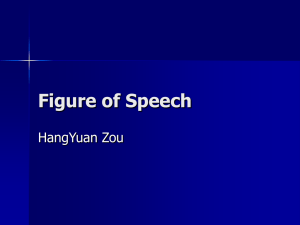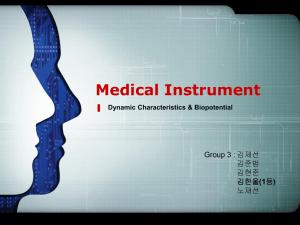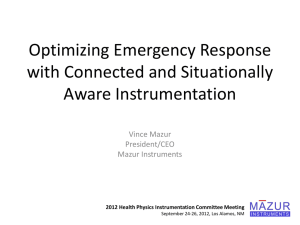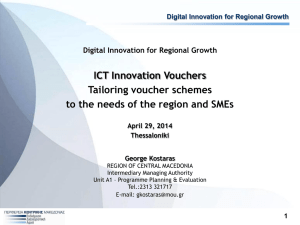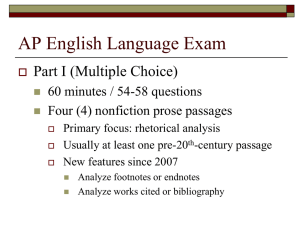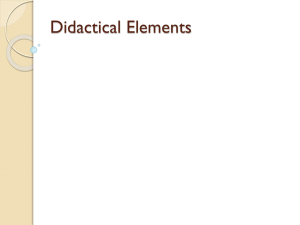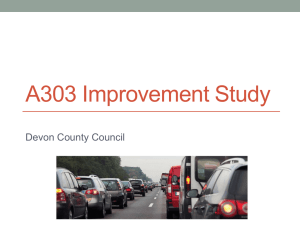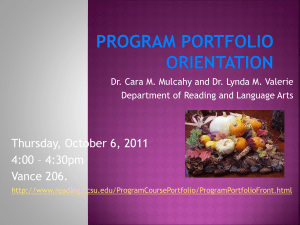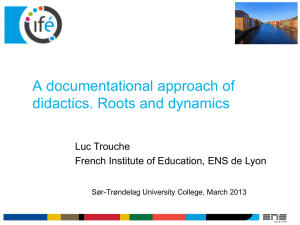New directions for instrumentation
advertisement
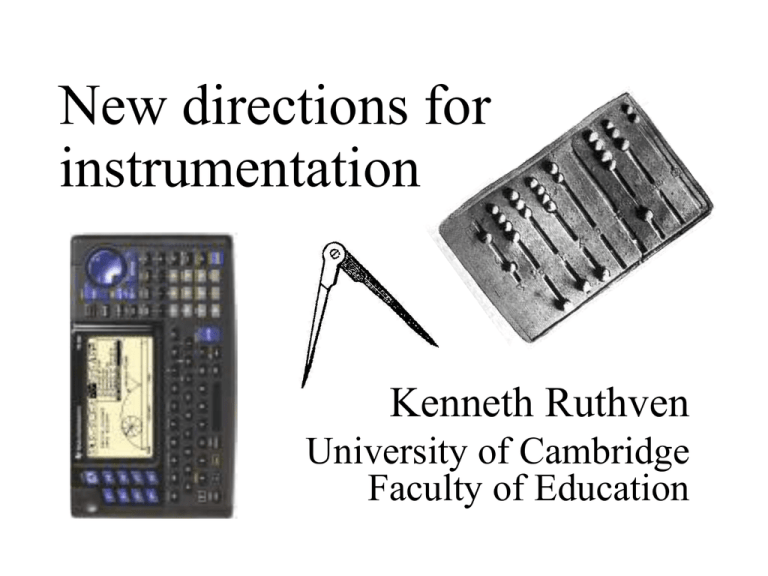
New directions for instrumentation Kenneth Ruthven University of Cambridge Faculty of Education Guin, D., Ruthven, K., & Trouche, L. [Eds.] (forthcoming, 2004). The didactical challenge of symbolic calculators: turning a computational device into a mathematical instrument (Kluwer, Dordrecht) ~500 pp. Instrumentation theory within cognitive ergonomics Rabardel, P. (2002) People And Technology: a cognitive approach to contemporary instruments http://ergoserv.psy.univ-paris8.fr/ New directions for instrumentation Broadening the empirical base – DGS/geometry in contrast to CAS/algebra – horizontal mathematisation in contrast to vertical – primary, technical-vocational & universityscholarly study in contrast to secondary Elucidating the theoretical frame – articulation with elements of didactical theory – clarification & systematisation of the theory – elaboration of micro- & macro-social aspects DGS/geometry v. CAS/algebra Provocative analogy – ‘a geometric calculator’, effecting [re]drawing (through [re]computing ‘geometrical functions’) – ‘a geometric laboratory’, aiding experimentation (through dragging and redefinition) – ‘a modeling tool for geometrical structures’ (identified through invariance under dragging) (Laborde in response to Cuoco and Goldenberg, 2003) Fundamental distinction – in (surface) semiotics and (target) mathematics, despite similar (computational) formalisation Horizontal v. vertical mathematisation Illustrative instrumentation studies – – – – equivalence of algebraic expressions (CAS) variation of functions (CAS) solution of parameterised equations (CAS) use of drag mode and trace tools in proof activity (DGS) Emphasis on – diffusing canonical mathematics over supporting progressive mathematisation – internal theorisation over external application Other settings v. secondary school Primary school mathematics – more connection to everyday & wider experience – emphasis on building broad flexible competence Technical-vocational mathematics – emphasis on pragmatic over epistemic aspects – more strongly contextualised in specific practice University-scholarly mathematics – emphasis on formal structural/symbolic modes of argument over informal/analogic/graphic – locally framed curriculum and assessment Instrumentation & didactique: individual cognition Both instrumentation & didactique treat schemes as the basis for (already functioning & developing) conceptions & competencies [Piaget;Vergnaud] Didactique emphasises the grounding of concepts in interplay between reference situations, operational invariants & semiotic systems [Vergnaud] Instrumentation & didactique: cultural practice Within didactique, mathematical activity is theorised in ‘praxeological’ terms[Chevallard] – task & technique – technical & theoretical discourses Within instrumentation, theorisation of cultural practice is less central, although passing reference [Rabardel] is made to: – anthropological approach [Chevallard] – cultural-historical approach [Engeström] Instrumentation & didactique: mathematical representation Computational transposition [Balacheff] (adapted from didactical transposition [Chevallard]) establishes operational constraints, requires perceptual adaptation [Trouche], & creates phenomena of pseudo-transparency & double reference [Artigue] Instrumentation & didactique: managed learning An instrumental orchestration [Guin & Trouche] is part of a didactical exploitation scenario [Chevallard] designed to exploit a mathematical [(a)didactical] situation [Brousseau] An e n vi ron m e n t A locus, a t eacher, students, art ifact s, instrument s syst ems A m ath e mati cal si tuati on A di dacti cal e xpl oi tati on sce nario (depending on t he environment and t he sit uation) Man age me n t of di ffe re nt si tuati on stage s An i n stru me ntal orch e stration (for each sit uation stage) A n e w e nviron me n t (Inst rument s and inst ruments systems move from one st at e t o another one) Instrumental mediation (Rabardel) Instrumentalization of ‘instrument’ Clarifying instrument “An instrument is defined as a system incorporating an artifact… and one or more utilization schemes: –usage schemes are orientated towards secondary tasks corresponding to the specific actions and activities directly related to the artifact; –instrument-mediated action schemes (incorporating usage schemes) are directed towards those primary tasks constituting the subject’s main goal.” Why identify ‘instrument’ with an artifact+scheme system, rather than (as in common usage) with an artifact by virtue of its place in (many) such systems? Clarifying instrumenta[liza]tion “We will use the term instrumentation… to designate aspects of the instrumental genesis process oriented toward the subject him/herself. We reserve that of instrumentalization for processes directed toward the artifact…These two types of processes are born of the subject. Instrumentalization by attributing a function to the artifact results from his/her activity, as does the adaptation of his/her schemes.” If both types of process are born of the subject, why not take instrumentation (in its more normal sense) as designating a process oriented towards the interaction between subject and object? Interactional limitations of instrumental mediation The situationally inflexible response of machines, their lack of interpretive capacity, limits the scope of human interaction with them (Suchmann, 1987) Experts often underestimate complexity of instrumented tasks, and overestimate interpretability of machine ‘feedback’ (Laborde, 2001) Automation –like routinisation– curtails the kinds of accounting for mathematical actions which underpin classroom communication, including the intersubjective processes of appropriation central to effective teaching and learning (Ruthven, 2002) Collective instrumented activity “Instrumental usage is often located in the context of a collective activity… A third level of schemes must, therefore, be considered: that of instrument-mediated collective activity schemes… These concern the specification of the types of action or activity, of the types of acceptable results… when the group shares a same instrument or works with a same class of instruments. They also concern the coordination of individual actions and integration of their results as a contribution to the achievement of common goals.” Socialising instrumented activity “ Utilization schemes have both private and social dimensions. The private dimension is specific to each individual. The social dimension comes from the fact that schemes develop in the course of a process in which the subject is not isolated. Other users, as well as artifact designers, contribute to this emergence of schemes. Schemes are the object of… transmissions and transfers… The social nature of schemes can by no means be confused with the fact that some of them are relative to instrument-mediated collective activities.” Logically but not functionally distinct? Joint activity highly pedagogically significant? Instrumented joint activity Joint instrumented activity (Rabardel & Bourmaud) Instrumental orchestration (Guin & Trouche) Disrupted didactical activity transparent system Tool salient expert known Subject Object pioneer reframed devalorised stable Norms emergent established Community extended Distribution of Labour required Competing didactical activity systems epistemic Tool pragmatic Teacher preconceived Student emergent Subject Object level-raising adidactical Norms didactical professional Community lay/peer Distribution of Labour effort-avoiding kr18@cam.ac.uk
